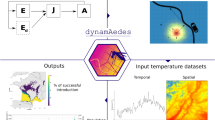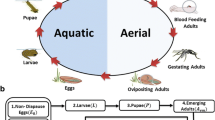Abstract
Aedes aegypti is the main vector for dengue and urban yellow fever. It is extended around the world not only in the tropical regions but also beyond them, reaching temperate climates. Because of its importance as a vector of deadly diseases, the significance of its distribution in urban areas and the possibility of breeding in laboratory facilities, Aedes aegypti is one of the best-known mosquitoes. In this work the biology of Aedes aegypti is incorporated into the framework of a stochastic population dynamics model able to handle seasonal and total extinction as well as endemic situations. The model incorporates explicitly the dependence with temperature. The ecological parameters of the model are tuned to the present populations of Aedes aegypti in Buenos Aires city, which is at the border of the present day geographical distribution in South America. Temperature thresholds for the mosquito survival are computed as a function of average yearly temperature and seasonal variation as well as breeding site availability. The stochastic analysis suggests that the southern limit of Aedes aegypti distribution in South America is close to the 15^∘C average yearly isotherm, which accounts for the historical and current distribution better than the traditional criterion of the winter (July) 10°C isotherm.
Similar content being viewed by others
References
Andersson, H., Britton, T., 2000. Stochastic epidemic models and their statistical analysis. Volume 151 of Lecture Notes in Statistics. Springer-Verlag, Berlin.
Aparicio, J.P., Solari, H.G., 2001. Population dynamics: A poissonian approximation and its relation to the langevin process. Phys. Rev. Lett. 86, 4183–4186.
Arrivillaga, J., Barrera, R., 2004. Food as a limiting factor for aedes aegypti in water-storage containers. J. Vector Ecol. 29, 11–20.
Bar-Zeev, M., 1957. The effect of density on the larvae of a mosquito and its influence on fecundity. Bull. Res. Council Israel 6B, 220–228.
Bar-Zeev, M., 1958. The effect of temperature on the growth rate and survival of the immature stages of aedes aegypti. Bull. Entomol. Res. 49, 157–163.
Campos, R.E., Macia, A., 1996. Observaciones biologicas de una poblacion natural de aedes aegypti (diptera: culicidae) en la provincia de buenos aires, argentina. Rev. Soc. Entomol. Argent. 55(1–4), 67–72.
Carbajo, A.E., Schweigmann, N., Curto, S.I., de Garín, A., Bejarán, R., 2001. Dengue transmission risk maps of argentina. Trop. Med. Int. Health 6(3), 170–183.
Carter, H.R., 1931. Yellow Fever: An Epidemiological and Historical Study of Its Place of Origin. The Williams & Wilkins Company, Baltimore.
Christophers, R., 1960. Aedes aegypti (L.), The Yellow Fever Mosquito. Cambridge Univ. Press., Cambridge.
de Garín, A.B., Bejarán, R.A., Carbajo, A.E., de Casas, S.C., Schweigmann, N.J., 2000. Atmospheric control of aedes aegypti populations in buenos aires (argentina) and its variability. Int. J. Biometerol. 44, 148–156.
Depinay, J.-M.O., Mbogo, C.M., Killeen, G., Knols, B., Beier, J., Carlson, J., Dushoff, J., Billingsley, P., Mwambi, H., Githure, J., Toure, A.M., McKenzie, F.E., 2004. A simulation model of african anopheles ecology and population dynamics for the analysis of malaria transmision. Malaria J. 3(29), 1–21.
Domínguez, C., Almeida, F.F.L., Almirón, W., 2000. Dinámica poblacional de aedes aegypti (diptera: Culicidae) en córdoba capital. Revista de la Sociedad Entomológica de Argentina 59, 41–50.
Dye, C., 1982. Intraspecific competition amongst larval aedes aegypti: Food exploitation or chemical interference. Ecol. Entomol. 7, 39–46.
Ethier, S.N., Kurtz, T.G., 1986. Markov Processes. John Wiley and Sons, New York.
Fay, R.W., 1964. The biology and bionomics of aedes aegypti in the laboratory. Mosq. News. 24, 300–308.
Focks, D.A., Haile, D.C., Daniels, E., Moun, G.A., 1993a. Dynamics life table model for aedes aegypti: Analysis of the literature and model development. J. Med. Entomol. 30, 1003–1018.
Focks, D.A., Haile, D.C., Daniels, E., Mount, G.A., 1993b. Dynamic life table model for aedes aegypti: Simulations results. J. Med. Entomol. 30, 1019–1029.
FUNCEI, 1998. Dengue enfermedad emergente. Fundación de estudios infectológicos 1(1), 1–6, http://www.funcei.org.ar.
FUNCEI, 1999a. Dengue enfermedad emergente. Fundación de estudios infectológicos 2(2), 1–8, http://www.funcei.org.ar.
FUNCEI, 1999b. Dengue enfermedad emergente. Fundación de estudios infectológicos 2(1), 1–12, http://www.funcei.org.ar.
Gleiser, R.M., Urrutia, J., Gorla, D.E., 2000. Effects of crowding on populations of aedes albifasciatus larvae under laboratory conditions. Entomologia Experimentalis et Applicata 95, 135–140.
Hill, G.W., 1877. On the part of motion of the lunar perigee which is function of the mean motions of the sun and moon. Acta Math. 8, 1.
Horsfall, W.R., 1955. Mosquitoes: Their Bionomics and Relation to Disease. Ronald, New York, USA.
Király, A., Jánosi, I. M., 2002. Stochastic modelling of daily temperature fluctuations. Phys. Rev. E 65, 051102.
Kurtz, T.G., 1970. Solutions of ordinary differential equations as limits of pure jump markov processes. J. Appl. Prob. 7, 49–58.
Kurtz, T.G., 1971. Limit theorems for sequences of jump processes approximating ordinary differential equations. J. Appl. Prob. 8, 344–356.
Legates, D.R., Willmott, C.J., 1990. Mean seasonal and spatial variability in global surface air temperature. Theor. Appl. Climatology 41, 11–21.
Livdahl, T.P., Koenekoop, R.K., Futterweit, S.G., 1984. The complex hatching response of aedes eggs to larval density. Ecol. Entomol. 9, 437–442.
Ministerio de Asistencia Social y Salud Publica, A., 1964. Campaña de erradicacion del Aedes aegypti en la Republica Argentina. Informe final. Buenos Aires.
Morales, M.A., Monteros, M., Fabbri, C.M., Garay, M.E., Introini, V., Ubeid, M.C., Baroni, P.G., Rodriguez, C., Ranaivoarisoa, M.I., Lanfri, M., Scavuzzo, M., Gentile, A., Zaidemberg, M., Ripoll, C. M., Fernandez, H., Blanco, S., Enria, D.A., 2004. Riesgo de aparicin de dengue hemorrágico en la argentina. In: II Congreso Internacional Dengue y Fiebre Amarilla. La Habana, Cuba, http://www.cidfa2004.sld.cu.
Nayar, J.K., Sauerman, D.M., 1975. The effects of nutrition on survival and fecundity in florida mosquitoes. part 3. utilization of bood and sugar for fecundity. J. Med. Entomol. 12, 220–225.
Perillo, G.M.E., Piccolo, M.C., 2004. quées el estuario de bahía blanca? Ciencia Hoy 14(81), 8–15, on line at http://www.ciencia-hoy.retina.ar.
Powell, J.A., Jenkis, J.L., 2000. Seasonal temperature alone can synchronize life cycles. Bull. Math. Biol. 62, 977–998.
Rueda, L.M., Patel, K.J., Axtell, R.C., Stinner, R.E., 1990. Temperature-dependent development and survival rates of culex quinquefasciatus and aedes aegypti (diptera: Culicidae). J. Med. Entomol. 27, 892–898.
Schoofield, R.M., Sharpe, P.J.H., Magnuson, C.E., 1981. Non-linear regression of biological temperature-dependent rate models based on absolute reaction-rate theory. J. Theor. Biol. 88, 719–731.
Schuster, H.G., 1984. Deterministic Chaos. Physik Verlag, Weinheim.
Schweigmann, N., Boffi, R., 1998. Aedes aegypti y aedes albopictus: Situación entomológica en la región. In: Temas de Zoonosis y Enfermedades Emergentes, Segundo Cong. Argent. de Zoonosis y Primer Cong. Argent. y Lationoamer. de Enf. Emerg. y Asociación Argentina de Zoonosis. Buenos Aires, pp. 259–263.
Sharpe, P.J.H., DeMichele, D.W., 1977. Reaction kinetics of poikilotherm development. J. Theor. Biol. 64, 649–670.
Solari, H., Natiello, M., Mindlin, B., 1996. Nonlinear Dynamics: A Two-way Trip from Physics to Math. Institute of Physics, Bristol.
Solari, H., Natiello, M., 2003a. Poisson approximation to density dependent stochastic processes: A numerical implementation and test. In: Khrennikov, A. (Ed.), Mathematical Modelling in Physics, Engineering and Cognitive Sciences. Proceedings of the Workshop Dynamical Systems from Number Theory to Probability–2, vol. 6.Växjö University Press, Växjö, pp. 79–94.
Solari, H.G., Natiello, M.A., 2003b. Stochastic population dynamics: the poisson approximation. Phys. Rev. E 67, 031918.
Southwood, T.R.E., Murdie, G., Yasuno, M., Tonn, R.J., Reader, P.M., 1972. Studies on the life budget of aedes aegypti in wat samphaya bangkok thailand. Bull. W.H.O. 46, 211–226.
Subra, R., Mouchet, J., 1984. The regulation of preimaginal populations of aedes aegypti (l.) (diptera: Culicidae) on the kenya coast. ii. food as a main regulatory fa ctor. Ann. Trop. Med. Parasitol. 78, 63–70.
Trpis, M., 1972. Dry season survival of aedes aegypti eggs in various breeding sites in the dar salaam area, tanzania. Bull. WHO 47, 433–437.
Vezzani, C., Velázquez, S.T., Schweigmann, N., 2004. Seasonal pattern of abundance of aedes aegypti (diptera: Culicidae) in buenos aires city, argentina. Memor Inst Oswaldo Cruz 99, 351–356.
WHO, 1998. Dengue Hemorrhagic Fever. Diagnosis, Treatment, Prevention and Control. World Health Organization, Ginebra, Suiza.
Wiggins, S., 1988. Global Bifurcations and Chaos. No. 73. Applied Mathematical Science.
Wiggins, S., 1990. Introduction to Applied Nonlinear Dynamical Systems and Chaos. Springer, New York.
Author information
Authors and Affiliations
Corresponding author
Rights and permissions
About this article
Cite this article
Otero, M., Solari, H.G. & Schweigmann, N. A Stochastic Population Dynamics Model for Aedes Aegypti: Formulation and Application to a City with Temperate Climate. Bull. Math. Biol. 68, 1945–1974 (2006). https://doi.org/10.1007/s11538-006-9067-y
Received:
Accepted:
Published:
Issue Date:
DOI: https://doi.org/10.1007/s11538-006-9067-y




